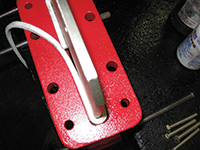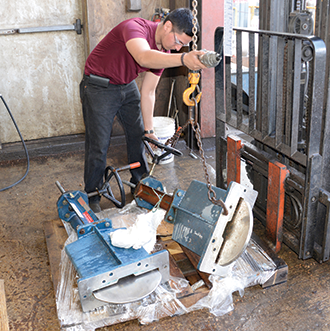The Challenges of Slurry Valve Packing
Because of the difficulties of dealing with slurry as a medium, the equipment assigned to move it along faces many challenges.
#automation
Even though these solids end up being the final cause of packing failure, the root cause is best determined through inspection of the failed packing and valve. Those who do that inspection should be looking at:
- Temperature issues—Although it seems obvious that packing should be selected to be compatible with the temperatures of the application, it doesn’t always happen. Signs of burning or glazing, especially on the lower rings, can be indicators of excessive temperature.
- Chemical compatibility—Slurries, especially in the ore processing and chemical industries, contain corrosive or aggressive chemicals. Signs of chemical attack often are either a hardening or softening of the packing. Chemical attack can also result in discoloration of the yarn. The packing should be compatible with any chemicals in use, including ones that may be used to clean equipment in between batches.
- Extrusion—The bottom ring should be checked for signs of extrusion past the throat of the stuffing box, and the top ring should be checked for extrusion around the gland nose. Extrusion could be the result of poor design, tolerances or wear over time. Extrusion out of the bottom of the stuffing box can be addressed with a bushing, and extrusion around the gland can be remedied with a new, tighter tolerance gland.
- Abrasion—If the media is physically attacking the packing, a wiper ring at the bottom of the stuffing box should be considered. This can be either a very tough packing such as a para-aramid fiber ring or a polymer lip seal. A wiper is always recommended in media that tend to develop a scale, such as lime slurry. Manufacturers also are making packing that combines a tough, resilient material with a softer material for better sealing capabilities.
VALVE INSPECTION
- Inspect all of stem/gate—The valve should be all the way open to inspect the entire stem/gate. Look for burrs or scaling that could potentially damage the packing as the valve actuates or any axial scoring that would open easy leak paths. Inspect for evidence of metal-to-metal contact.
- Inspect the gland—The gland should be able to freely enter the stuffing box all the way. Note whether the gland nose is less than one packing cross section high. If so, it will limit the ability to adjust the packing as it consolidates. When this is the case, consider purchasing a gland with a longer nose.
- Stem concentricity/movement—Measure the stem’s distance from the bore of the stuffing box in several locations to ensure it is concentric. Fully actuate the valve, stopping to measure several times to ensure the stem remains concentric through the entire cycle. Keep in mind that in gate valves, seats are often misaligned, causing radial shaft movement when the valve closes.
- Deep stuffing boxes—While it may seem logical that more packing rings would create a better seal, excessively deep stuffing boxes that require six or more packing rings can create unnecessary issues. This is because all packing consolidates over time, and more packing rings will lead to more consolidation and require more frequent gland adjustments. Testing has also shown that very little gland load is transferred beyond five rings, so deeper rings will not expand to create a seal. Testing has shown that four to six packing rings is optimal. Deep stuffing boxes can be fitted with a split carbon or bronze bushing.
- Knife-gate valve issues—Knife gates are some of the most common valves used in slurry service. While some knife gates seal on the valve stem with a standard cylindrical stuffing box, many seal on the gate with a rectangular stuffing box. Packing can have trouble conforming around the sharp corners of the gate; the large sealing surface gives more opportunities for leak paths to form. In this case, more pliable packing may be needed. Using a knife gate that seals on the gate for any service where leakage cannot be tolerated, such as toxic or otherwise dangerous media, is not recommended.
Knife gates on vertical pipes are often mounted horizontally. (If clearance around the pipe allows, it may be best to mount the knife gate vertically.) Horizontal mounting causes the weight of the gate to over-compress one side of the packing and under-compress the other, resulting in leakage. In this case, consulting the manufacturer on how to better support both the gate and valve to keep it aligned is recommended.
INSTALLATION
- Cutting the rings—Using skive cut rings (a 45-degree cut) for slurry service is recommended to make it more difficult for solids to get into the cut. Using a sharp knife and avoiding too much back-and-forth sawing also is extremely important to make the cut as clean as possible. The cut is the weak point in a packing ring so it’s worth the extra time and effort to make it as strong as possible. Cut rings also should always be checked against the stem, gate or a mandrel for fit. Many manufacturers offer pre-cut rings, which can reduce operator error.
- Installing the rings—Every ring should be tamped snugly into place, especially the bottom ring. If that bottom ring is not tamped firmly into place, the gland will not necessarily move the ring into position before startup. If solids penetrate the packing set before the rings settle into position, the life of the packing is drastically reduced. The splits should be rotated 90 degrees between each ring, unless the installation is on a knife gate valve that seals on the gate. In that case, splits can be rotated 180 degrees.
- Tightening the gland—First, ensure the nut can freely travel along the threads of the bolt, and that the threads are free of corrosion/burrs. Alternately, tighten the gland bolts to compress the packing evenly. The packing manufacturer should be consulted for information on gland bolt torque, noting whether that manufacturer specifies a torque with or without anti-seize. A best practice is to always use a high-quality anti-seize on valve gland bolts.
- A note on control valves and critical valves—Control valves present a more difficult sealing application because they are actuated far more frequently than a typical block or on/off valve. Valves also should be ranked by criticality based on temperature, pressure, the media they are sealing and the consequences of packing failure. For these valves, pre-consolidating the packing by actuating the valve several times might be considered, then retightening the gland. This process should continue until the gland is not noticeably looser after actuation. For better results, a calibrated torque wrench should be used. On “bad actor” or particularly critical valves, disc springs under the gland bolts can be used to better maintain load on the packing set as it consolidates.
In conclusion, slurry valves are a difficult environment for packing to seal. However, proper packing selection, failure analysis and installation can drastically affect success.
Cameron Rapoport began working at A.W. Chesterton (www.chesterton.com) in 2013 and is currently a field product manager responsible for packing and gaskets for rotating and stationary equipment. Reach him at cameron.rapoport @chesterton.com
RELATED CONTENT
-
Valve Selection for Bypass of Control Valves: A Case Study
A bypass line including a bypass valve is typically installed to provide continuous operation in case of regular maintenance of a control valve.
-
The Different Types of Solenoid Valves and How They Work
Solenoid valves are automatic flow control devices popular across different industrial applications.
-
Fugitive Emissions Standards for Valves
API, ISO and TA Luft all have their own set of standards to control emissions. What are the differences and how do they compare?













 Unloading large gate valve.jpg;maxWidth=214)